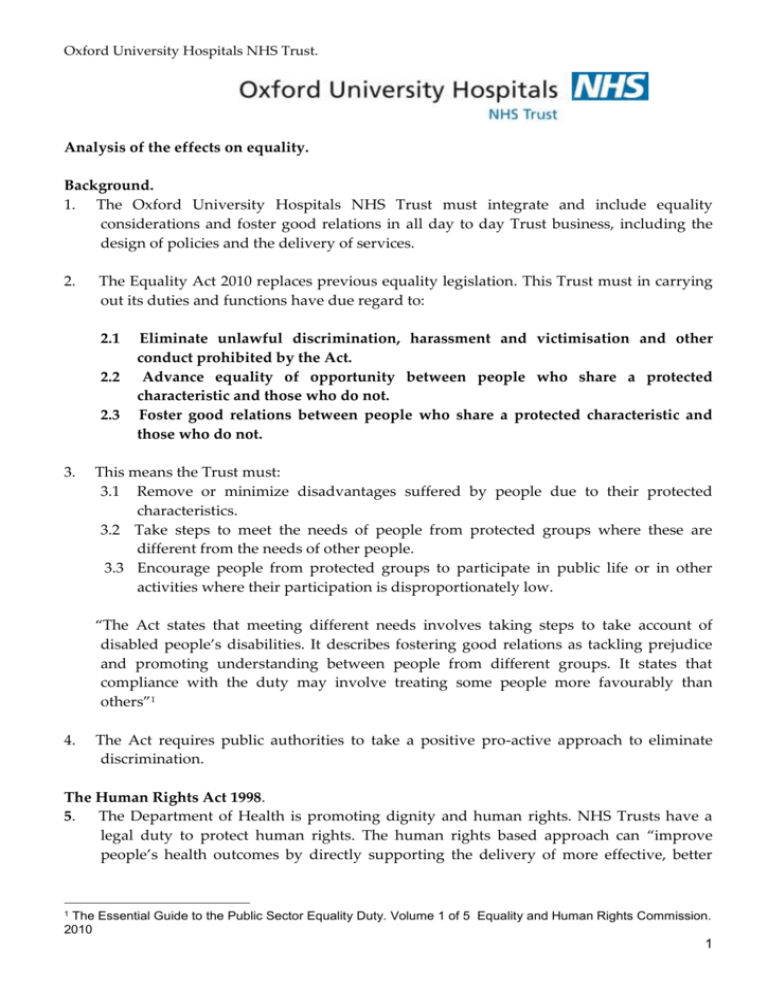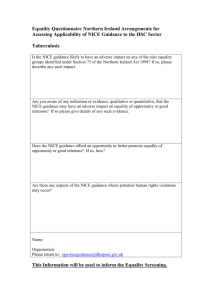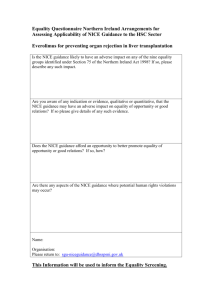Equality Analysis Form - Oxford University Hospitals NHS Trust
advertisement

Oxford University Hospitals NHS Trust. Analysis of the effects on equality. Background. 1. The Oxford University Hospitals NHS Trust must integrate and include equality considerations and foster good relations in all day to day Trust business, including the design of policies and the delivery of services. 2. The Equality Act 2010 replaces previous equality legislation. This Trust must in carrying out its duties and functions have due regard to: 2.1 2.2 2.3 3. Eliminate unlawful discrimination, harassment and victimisation and other conduct prohibited by the Act. Advance equality of opportunity between people who share a protected characteristic and those who do not. Foster good relations between people who share a protected characteristic and those who do not. This means the Trust must: 3.1 Remove or minimize disadvantages suffered by people due to their protected characteristics. 3.2 Take steps to meet the needs of people from protected groups where these are different from the needs of other people. 3.3 Encourage people from protected groups to participate in public life or in other activities where their participation is disproportionately low. “The Act states that meeting different needs involves taking steps to take account of disabled people’s disabilities. It describes fostering good relations as tackling prejudice and promoting understanding between people from different groups. It states that compliance with the duty may involve treating some people more favourably than others”1 4. The Act requires public authorities to take a positive pro-active approach to eliminate discrimination. The Human Rights Act 1998. 5. The Department of Health is promoting dignity and human rights. NHS Trusts have a legal duty to protect human rights. The human rights based approach can “improve people’s health outcomes by directly supporting the delivery of more effective, better 1 The Essential Guide to the Public Sector Equality Duty. Volume 1 of 5 Equality and Human Rights Commission. 2010 1 Oxford University Hospitals NHS Trust. quality, person centred health care2”. People have a right to be treated with dignity and respect. If people feel marginalised they may well feel disempowered and require advocacy. Staff need to be aware if vulnerable patients need help to ask and express their needs. Inequalities due to deprivation may also be considered; this is not part of equality legislation, but a government requirement to reduce inequalities. A policy may need to highlight different individual needs. Why conduct an Equality Analysis? 6. This is a requirement to help public authorities eliminate institutional discrimination. It is a way of examining whether different groups are adversely affected by policies, plans, proposals, services or functions. 7. This process will assist policy authors create a policy that includes analysis and wider involvement. 8. This will become part of standard practice, in conjunction with current policy writing guidance. Evidence that the Trust has carried out an equality analysis is required. Previous case law has established that equality impact assessments are an important way that public authorities can provide evidence that they are meeting the general duties. 9. The legislation and the need to carry out an equality analysis, is to reduce direct discrimination- when an individual is treated less favourably than other persons. The legislation also aims to reduce indirect discrimination, which can occur when policy and practices put groups at risk of being discriminated against or put groups at a disadvantage. 10. Decision makers must consider sufficient information to inform their decisions, document the evidence on the form and attach the evidence to the policy/plan/proposal. What is an Equality Analysis? 11. An equality analysis is a way of systematically and thoroughly assessing, and consulting on, the effects that a proposed policy, plan or proposal is likely to have on people, depending on their characteristic: race, disability, age, sex or sexual orientation, religion or belief, sexual orientation, people who have had a gender re-assignment, pregnancy or maternity and marriage and civil partnership. 12. 2 The main purpose is to pre-empt the possibility that a proposed policy may affect one group unfavourably. The process will help identify ways to change a policy, to help reduce any adverse impact or potential discrimination. There is also a need to set objectives and plan to improve the policy, service or function. The policy, plan or proposal must be explicit in how diverse needs will be met. Human Rights and Healthcare- A Framework for Local Action. Page 6 Dept of Health 2007 2 Oxford University Hospitals NHS Trust. The process 13. The Trust needs to give the highest priority to those functions and policies that have the greatest potential to affect different protected groups in different ways; E.g. affect disabled people in different ways, or different racial groups in different ways etc. 14. The weight given and time spent assessing a particular policy should be proportionate to its relevance. This means that a human resource policy or people oriented policy should be given more time than say a lottery or equipment policy. 15. Adverse impact occurs when one particular group – or groups, has been affected less favourably or negatively, compared to another group. 16. Example3: A policy on maternity services may not consider the needs of women based on their religious or cultural beliefs. This could adversely impact the quality of their care. 17. Example: A discharge policy may not identify the specific needs of disabled people or their carer. This could adversely impact the care that is provided to these patients whilst preparing to go home or following discharge. 18. People can be affected directly when one person is treated adversely, simply because of their ethnicity, religion or belief, disability, age, gender, sexual orientation, gender reassignment, pregnancy and maternity, marriage and civil partnership. 19. People can also be affected indirectly when a policy impacts a particular group / groups adversely. The impact may be unintentional, but unlawful and will need careful consideration. Some policies may affect different racial groups/disabled people more than others. 20. There are six key steps: 20.1 Identify the aims of the policy. When writing the policy, consider and explain the likely impact on the different protected groups. 20.2 Assess the likely impact of the policy – the evidence of the analysis must be available. 20.3 Involve stakeholders and ensure views of the public inform the policy development. Section 242 Health Service Act, requires the Trust to involve the public in on-going service development. 20.4 Decide whether to adopt the policy /plan/proposal. 3 Examples: Acknowledgement and thanks to Cambridge University Hospitals NHS Foundation Trust. 3 Oxford University Hospitals NHS Trust. 20.5 Attach the equality analysis to the policy so it can be seen on the intranet. 20.6 If the adverse impact on one group is to promote equality of opportunity for another group, then the adverse impact may be justified. There may be clinical reasons to treat groups or individuals affected by a policy differently. 20.7 Consider the risks to patients and risks to the Trust, such as safety, complaints and litigation. Department of Health guidance is available on the ORH Equality intranet site. Written by Jan Cottle updated Dec 2011 4 Oxford University Hospitals NHS Trust. EQUALITY ANALYSIS Eliminate unlawful discrimination, harassment and victimisation and other conduct prohibited by the Act. Advance equality of opportunity between people who share a protected characteristic and those who do not. Foster good relations between people who share a protected characteristic and those who do not. Please consider whether the policy or function/service/proposal, is likely to have an adverse impact on grounds of: race, disability, age, religion or belief, sex or sexual orientation, gender re-assignment, pregnancy and maternity, marriage or civil partnership, deprivation or human rights. Please include this in the preparation to write a policy and refer to the “Policy on Writing Policies.” Equality Analysis Policy / Plan / proposal name: Date of Policy Date due for review Lead person for policy and equality analysis Does the policy /proposal relate to people? If yes please complete the whole form. YES /NO The only policies and proposals not relevant to equality considerations are those not involving people at all. (E.g Equipment such as fridge temperature) 1. Identify the main aim and objectives and intended outcomes of the policy. Who will benefit from the policy? How is the policy likely to affect the promotion of equality considering: age, disability, gender, gender re-assignment, race, religion or belief, sexual orientation, pregnancy and maternity or human rights? 2. Involvement of stakeholders. 5 Oxford University Hospitals NHS Trust. List who has been involved in the policy/proposal development? Consider external diverse views from people with the different personal characteristics. Look at the intranet equality analysis guidance for more information on seeking views and involving the public. 3. Evidence. Look at all the evidence of the different ways the policy/ proposal may affect different groups. List the sources of data you have reviewed to decide on the impact on each of the equality groups. ( E.g. national research, local population information, information on the equality intranet, PALs, complaints and patient feedback). Population information on www.healthprofiles.info search for Oxfordshire. Disability Have you consulted with someone who has a disability? Attitudinal, physical and social barriers E.g People who are deaf need to have access to British Sign Language; people with a learning disability needs access to additional support and easy read information; people who have a physical disability must not be disadvantaged in accessing facilities such as for toilet/bathing. Sex Consider the potential impact on men and women E.g same sex accommodation and personal care. Age Will different age groups be affected differently? Is any age group at a disadvantage? Race Consider the impact of this policy/proposal on different ethnic groups such as gypsies and travellers or people who do not speak English. Consider cultural implications of what is proposed in the policy. Sexual orientation Consider the effect on heterosexual, gay, lesbian and bi-sexual people. Document any considerations. Consider staff attitude and involvement of same sex partners. 6 Oxford University Hospitals NHS Trust. Pregnancy and maternity Will the policy affect people who are pregnant or who have children less than one year differently? Consider working arrangements, part time working, caring responsibilities and breast- feeding facilities. Religion or belief. Will the proposal affect people of different religions or belief differently? E.g Consider implications for practicing their religion, dietary, fasting and festivals. Consult with ORH Chaplaincy Team for advice and guidance about how the policy may affect different groups, positively or negatively. Gender re-assignment. Will the policy or proposal affect transgender or transsexual people differently? Consider privacy issues and potential for harassment. Marriage or civil partnerships: Carers Remember to ensure carers are fully involved, informed, supported and they can express their concerns. Consider the need for flexible working. Safeguarding people who are vulnerable: How has this policy plan or proposal ensured that the organisation is safeguarding vulnerable people? ( E.g by providing communication aids or assistance in any other way.) Other potential impacts e.g. culture, human rights, socio economic e.g. homeless people Section 4 Summary of Analysis Does the evidence show any potential to discriminate? Please state how the policy or proposals impact on elimination of discrimination, harassment and victimisation. ( age, disability, sex, gender re-assignment, pregnancy and maternity, race, religion or belief, sexual orientation, marriage and civil partnerships and human rights). Are there any barriers to access or engagement? 7 Oxford University Hospitals NHS Trust. How will you reduce any negative impacts? If your assessment shows the policy or proposal is likely to have an adverse impact on a particular group and a potential to discriminate, please decide whether to: Make changes that will reduce concerns. Consider different ways of putting the proposed policy into practice, to reduce its potential to affect some groups adversely. Find alternative means of achieving the policy. Justify the policy, even though it could affect some groups adversely. Are you sure you can legally justify the action? If there is no alternative action to avoid discrimination please explain why. Are there aspects that could be changed? Could additional measures be taken to reduce or remove adverse impact without affecting the policy’s overall aims? If you decide the policy needs to go through without alteration, despite adverse impact, are you sure you can legally justify this action? How does the policy promote equality of opportunity? How does the policy advance equality of opportunity? (Age, disability, sex, gender reassignment, pregnancy and maternity, race, religion or belief, sexual orientation and human rights). This means minimizing disadvantage and meeting the needs of people, with protected characteristics and promoting their participation. How does the policy promote good relations between groups? (Promoting understanding) 8 Oxford University Hospitals NHS Trust. These prompts are intended to help you answer the questions more fully. The purpose 1.1 What is the main purpose of the policy or function? 1.2 What are you trying to achieve through the policy? 1.3 Have you involved stakeholders, patients, carers or the public in the policy development? 1.4 The wider involvement would help you identify and evidence whether the policy is required and may give you some information about how the policy may be implemented to avoid any discrimination. 1.5 What criteria are you going to use to measure progress towards the stated outcomes? 1.6 Can you look at practice elsewhere and gain from their experiences? Considering the evidence 2.1 What information do you need to develop an effective policy? 2.2 Speak to people who will be affected by the policy. 2.3 Is more information required to ensure there is not any adverse impact on a particular group? 2.4 If there is insufficient information you may need to make a judgement this time and ensure that information is collected for the next review. 2.5 Could other Trusts with similar polices advice as to what information they found useful? Please see the equality, diversity and human rights intranet site for sources of information. 2.6 In order to be fully informed before you write the policy or proposal, please consider possible sources of information such as: PALS, Complaints analysis, risk management, demographic data, recent research findings and surveys, studies of deprivation, equality monitoring data, qualitative information from those you have involved, recommendations from inspection reports and audits. 9









